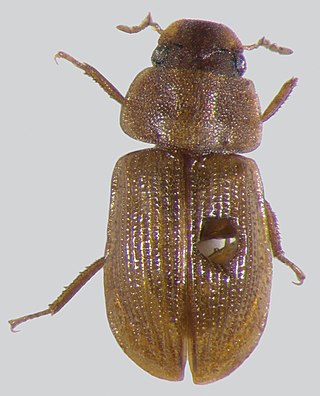
Flower chafers are a group of scarab beetles comprising the subfamily Cetoniinae. Many species are diurnal and visit flowers for pollen and nectar, or to browse on the petals. Some species also feed on fruit. The group is also called fruit and flower chafers, flower beetles and flower scarabs. There are around 4,000 species, many of them still undescribed.

Mecodema is a genus of large flightless ground beetle (Carabidae) endemic to New Zealand. The genus is very diverse in comparison to the other three New Zealand genera within the subtribe Nothobroscina. Mecodema is geographically widespread across both the North and South Islands, as well as numerous offshore islands, including the Three Kings Is., Poor Knights Is., Aotea and Hauturu, Kapiti Is., Stephens Is., Stewart Is., Chatham Is., Snares Is.

Tyrannasorus rex is an extinct species of hybosorid beetle known to exist in the Miocene epoch and the sole member of the monotypic genus Tyrannasorus. A fossilized example scarabaeoid was found embedded in the amber resin of Hymenaea protera in the Dominican Republic. The species was described by Brett C. Ratcliffe and Federico Carlos Ocampo in 2001.

Leptostylopsis annulipes is a species of longhorn beetles of the subfamily Lamiinae.

Cebrionini is a tribe of click beetles from the family Elateridae; formerly ranked as a subfamily or family, they are now considered a tribe within the subfamily Elaterinae.
Copelatus taprobanicus is a species of diving beetle endemic to Sri Lanka. It is part of the genus Copelatus in the subfamily Copelatinae of the family Dytiscidae. It was described by Wewalka & Vazirani in 1985.

Zigrasimecia is an extinct genus of ants which existed in the Cretaceous period approximately 98 million years ago. The first specimens were collected from Burmese amber in Kachin State, 100 kilometres (62 mi) west of Myitkyina town in Myanmar. In 2013, palaeoentomologists Phillip Barden and David Grimaldi published a paper describing and naming Zigrasimecia tonsora. They described a dealate female with unusual features, notably the highly specialized mandibles. Other features include large ocelli, short scapes, 12 antennomeres, small eyes, and a clypeal margin that has a row of peg-like denticles. The genus Zigrasimecia was originally incertae sedis within Formicidae until a second species, Zigrasimecia ferox, was described in 2014, leading to its placement in the subfamily Sphecomyrminae. Later, it was considered to belong to the distinct subfamily Zigrasimeciinae.
Bucolus fourneti is a native Australian, small, hairy coccinellid beetle approximately 2.1-4.5 mm in diameter. It was described by Étienne Mulsant in 1850
Monardiella is a genus of leaf beetles in the subfamily Eumolpinae. Mondardiella can be found in Africa.

Acidocerus aphodioides is a species of water scavenger beetle in the family Hydrophilidae. It is the only species in the genus Acidocerus. It is known only from Mozambique.
Hydroscapha monticola, is a species of skiff beetle native to India and Sri Lanka.
Hybosorus orientalis, is a species of scavenger scarab beetle found in Nepal, Pakistan, India, Sri Lanka, Afghanistan, Myanmar, Sumatra, and Java.
Phaeochrous elevatus, is a species of scavenger scarab beetle native to South India and Sri Lanka.

Phaeochrous emarginatus, is a species of scavenger scarab beetle found in India, Sri Lanka, Bhutan, China, Taiwan, Japan, Laos, Myanmar, Thailand, Malaysia, Vietnam, Indonesia, Philippines, New Guinea, Ryukyu Archipelago, and Australia.
Bolboceras insulare, is a species of dor beetle found in India, and Sri Lanka.
Ilamelmis starmuhlneri, is a species of riffle beetle found in Sri Lanka.
Harmatelia bilinea, is a species of firefly beetle endemic to Sri Lanka.

Cybister tripunctatus, is a species of predaceous diving beetle found in India, Andaman & Nicobar Islands, Sri Lanka, Afghanistan, Bangladesh, Myanmar, Nepal, Pakistan, Bhutan, China, Cyprus, Iran, Iraq, Japan, Kyrgyzstan, Mongolia, Russia, Syria, Tajikistan, Turkmenistan, Italy, Turkey, Uzbekistan and Europe.
Arixyleborus malayensis, is a species of weevil found in India, Sri Lanka, China, Japan, Malaysia, Vietnam and Indonesia. This is the only species of Arixyleborus found in Japan and China.
Clambus ceylonicus, is a species of fringe-winged beetle endemic to Sri Lanka.









